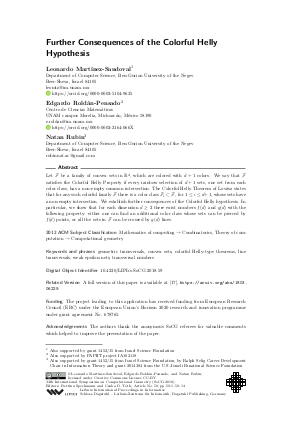Further Consequences of the Colorful Helly Hypothesis
Authors Leonardo Martínez-Sandoval, Edgardo Roldán-Pensado, Natan Rubin
-
Part of:
Volume:
34th International Symposium on Computational Geometry (SoCG 2018)
Part of: Series: Leibniz International Proceedings in Informatics (LIPIcs)
Part of: Conference: Symposium on Computational Geometry (SoCG) - License:
 Creative Commons Attribution 3.0 Unported license
Creative Commons Attribution 3.0 Unported license
- Publication Date: 2018-06-08
File

PDF
LIPIcs.SoCG.2018.59.pdf
- Filesize: 0.52 MB
- 14 pages
Document Identifiers
Subject Classification
Keywords
- geometric transversals
- convex sets
- colorful Helly-type theorems
- line transversals
- weak epsilon-nets
- transversal numbers
Metrics
- Access Statistics
-
Total Accesses (updated on a weekly basis)
0Document
0Metadata
Abstract
Let F be a family of convex sets in R^d, which are colored with d+1 colors. We say that F satisfies the Colorful Helly Property if every rainbow selection of d+1 sets, one set from each color class, has a non-empty common intersection. The Colorful Helly Theorem of Lovász states that for any such colorful family F there is a color class F_i subset F, for 1 <= i <= d+1, whose sets have a non-empty intersection. We establish further consequences of the Colorful Helly hypothesis. In particular, we show that for each dimension d >= 2 there exist numbers f(d) and g(d) with the following property: either one can find an additional color class whose sets can be pierced by f(d) points, or all the sets in F can be crossed by g(d) lines.
Cite As Get BibTex
Leonardo Martínez-Sandoval, Edgardo Roldán-Pensado, and Natan Rubin. Further Consequences of the Colorful Helly Hypothesis. In 34th International Symposium on Computational Geometry (SoCG 2018). Leibniz International Proceedings in Informatics (LIPIcs), Volume 99, pp. 59:1-59:14, Schloss Dagstuhl – Leibniz-Zentrum für Informatik (2018)
https://doi.org/10.4230/LIPIcs.SoCG.2018.59
BibTex
@InProceedings{martinezsandoval_et_al:LIPIcs.SoCG.2018.59,
author = {Mart{\'\i}nez-Sandoval, Leonardo and Rold\'{a}n-Pensado, Edgardo and Rubin, Natan},
title = {{Further Consequences of the Colorful Helly Hypothesis}},
booktitle = {34th International Symposium on Computational Geometry (SoCG 2018)},
pages = {59:1--59:14},
series = {Leibniz International Proceedings in Informatics (LIPIcs)},
ISBN = {978-3-95977-066-8},
ISSN = {1868-8969},
year = {2018},
volume = {99},
editor = {Speckmann, Bettina and T\'{o}th, Csaba D.},
publisher = {Schloss Dagstuhl -- Leibniz-Zentrum f{\"u}r Informatik},
address = {Dagstuhl, Germany},
URL = {https://drops.dagstuhl.de/entities/document/10.4230/LIPIcs.SoCG.2018.59},
URN = {urn:nbn:de:0030-drops-87726},
doi = {10.4230/LIPIcs.SoCG.2018.59},
annote = {Keywords: geometric transversals, convex sets, colorful Helly-type theorems, line transversals, weak epsilon-nets, transversal numbers}
}
Author Details
References
-
N. Alon, I. Bárány, Z. Füredi, and D. J. Kleitman. Point selections and weak ε-nets for convex hulls. Combinatorics Probability and Computing, 1(3):189-200, 1992.

-
N. Alon and G. Kalai. Bounding the piercing number. Discrete & Computational Geometry, 13(3):245-256, 1995.

-
N. Alon, G. Kalai, J. Matoušek, and R. Meshulam. Transversal numbers for hypergraphs arising in geometry. Advances in Applied Mathematics, 29(1):79-101, 2002.

-
N. Alon and D. J. Kleitman. Piercing convex sets and the Hadwiger-Debrunner (p, q)-problem. Advances in Mathematics, 96(1):103-112, 1992.

- N. Amenta, J. A. De Loera, and P. Soberón. Helly’s Theorem: New Variations and Applications. Contemporary Mathematics, 685:55-95, 2017. URL: https://arxiv.org/abs/1508.07606.
-
J. L. Arocha, I. Bárány, J. Bracho, R. Fabila, and L. Montejano. Very colorful theorems. Discrete & Computational Geometry, 42(2):142-154, 2009.

-
I. Bárány. A generalization of Carathéodory’s theorem. Discrete Mathematics, 40(2-3):141-152, 1982.

-
I. Bárány. Tensors, colours, octahedra. In Geometry, Structure and Randomness in Combinatorics, pages 1-17. Springer, 2014.

-
L. Danzer. Über ein Problem aus der kombinatorischen Geometrie. Archiv der Mathematik, 8(5):347-351, 1957.

-
L. Danzer, B. Grünbaum, and V. Klee. Helly’s theorem and its relatives. Proceedings of symposia in pure mathematics: Convexity. American Mathematical Society, 1963.

-
J. Eckhoff. Handbook of Convex Geometry, chapter Helly, Radon, and Carathéodory type theorems, pages 389-448. Elsevier, 1990.

-
J. E. Goodman, R. Pollack, and R. Wenger. New Trends in Discrete and Computational Geometry, chapter Geometric Transversal Theory, pages 163-198. Springer Berlin Heidelberg, Berlin, Heidelberg, 1993.

-
H. Hadwiger and H. Debrunner. Über eine Variante zum Helly’schen Satz. Arch. Math., 8:309-313, 1957.

-
E. Helly. Über Mengen konvexer Körper mit gemeinschaftlichen Punkte. Jahresbericht der Deutschen Mathematiker-Vereinigung, 32:175-176, 1923.

-
A. F. Holmsen, J. Pach, and H. Tverberg. Points surrounding the origin. Combinatorica, 28(6):633-644, 2008.

-
M. Katchalski and A. Liu. A problem of geometry in Rⁿ. Proceedings of the American Mathematical Society, 75(2):284-288, 1979.

- Leonardo Martínez-Sandoval, Edgardo Roldán-Pensado, and Natan Rubin. Further consequences of the colorful helly hypothesis. arXiv preprint, 2018. URL: https://arxiv.org/abs/1803.06229.
-
L. Santaló. Un teorema sobre conjuntos de paralelepípedos de aristas paralelas. Publicaciones del Instituto de Matemáticas, Universidad Nacional del Litoral, II(4):49-60, 1940.

-
R. Wenger and A. Holmsen. The Handbook of Discrete and Computational Geometry, chapter Helly-type Theorems and Geometric Transversals, pages 91-124. Chapman and Hall/CRC, third edition edition, 2017.

